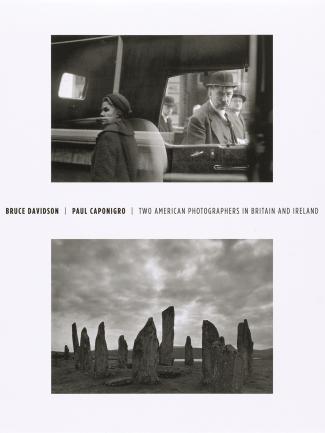Paired for the first time in an exhibition, Paul Caponigro (b. 1932) and Bruce Davidson (b. 1933) are two of the most distinguished photographers of their generation. The artistic styles and temperaments of Caponigro and Davidson could not be more different: Davidson is a photojournalist and an exponent of gritty street photography; Caponigro practices a pure, formalist approach to landscape. Yet both are devoted to traditional photographic methods using film and are masters of the dark room, and both produced important bodies of work in Britain and Ireland beginning in the 1960s. In trips to Britain in 1960 and 1965, Davidson took an impressionistic portrait of the British people at work and play. Caponigro, in numerous visits beginning in 1966, focused on the ancient stone circles, dolmens, and early churches in the British and Celtic landscape.
Paul Caponigro, a protégé of Minor White and a follower of the West Coast movement inspired by Ansel Adams and Edward Weston, has been an active photographer since 1952. Caponigro traveled to Ireland in 1966 on a Guggenheim Fellowship. He had planned to explore Egypt as his subject but was dissuaded by the photographer Dorothea Lange, who urged him to consider the megalithic structures of Ireland and Britain. As Caponigro recalled, “Ireland became my Egypt and the stones became my temples.” He visited Ireland and Britain fifteen times between 1966 and 1977, and has continued to make periodic visits.
While Caponigro’s work focuses on natural elements and primeval monuments, Bruce Davidson has said that he is “not a rocks and trees photographer.” Since 1958, Davidson has worked with Magnum Photos, the renowned photo agency co-founded in 1947 by Henri Cartier Bresson, Robert Capa, and a group of likeminded photojournalists. Davidson’s work reflects Cartier-Bresson’s concept of capturing the “decisive moment,” a meaningful instant caught and isolated from the ongoing life flowing around the photographer. Following his highly acclaimed late 1950s Brooklyn Gang series, Davidson worked on commission for the Queen magazine in England and Scotland in the autumn of 1960. He returned in 1965 to photograph Blackpool, a mecca for working-class British holidaymakers, and the mining communities of southern Wales. In 1967 he traveled to Ireland to photograph a traveling family circus.
Credits
Bruce Davidson/Paul Caponigro: Two American Photographers in Britain and Ireland includes approximately 150 photographs. It was co-organized by the Yale Center for British Art and The Huntington Library, Art Collections, and Botanical Gardens, where it will be on display from November 8, 2014, to March 9, 2015. The exhibition was curated by Scott Wilcox, Chief Curator of Art Collections and Senior Curator of Prints and Drawings at the Center, and Jennifer A. Watts, Curator of Photographs at The Huntington Library. A fully illustrated catalogue with curatorial essays, published in association with Yale University Press, accompanies the exhibition and has been supported by a generous gift from Kelvin Davis.
Top image
Bruce Davidson/Paul Caponigro: Two American Photographers in Britain and Ireland installation, Yale Center for British Art, photo by Richard Caspole
Extended reading

Bruce Davidson/Paul Caponigro: Two American Photographers in Britain and Ireland
Written by Jennifer A. Watts and Scott Wilcox